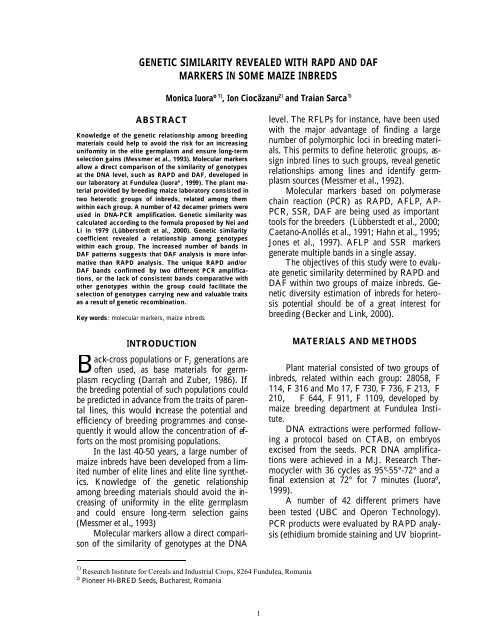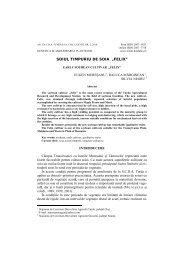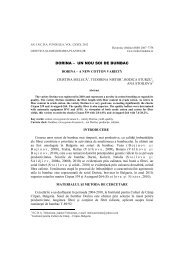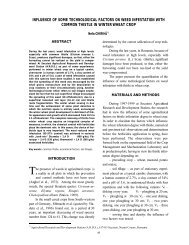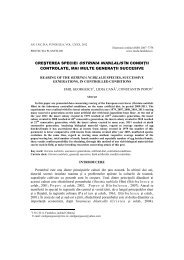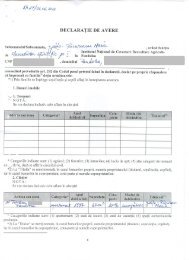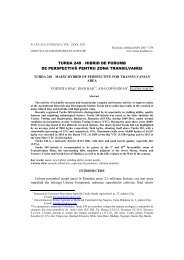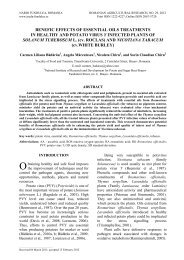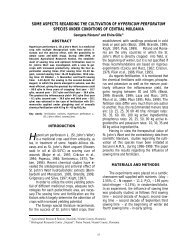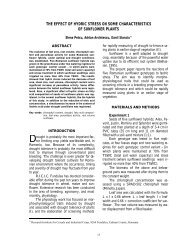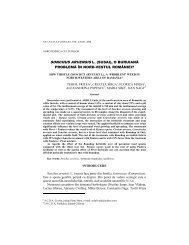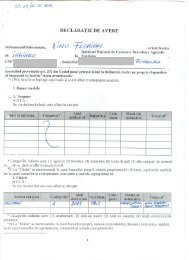genetic similarity revealed with rapd and daf markers in some maize ...
genetic similarity revealed with rapd and daf markers in some maize ...
genetic similarity revealed with rapd and daf markers in some maize ...
Create successful ePaper yourself
Turn your PDF publications into a flip-book with our unique Google optimized e-Paper software.
GENETIC SIMILARITY REVEALED WITH RAPD AND DAF<br />
MARKERS IN SOME MAIZE INBREDS<br />
Monica Iuoraº 1) , Ion Ciocãzanu 2) <strong>and</strong> Traian Sarca 1)<br />
ABSTRACT<br />
Knowledge of the <strong>genetic</strong> relationship among breed<strong>in</strong>g<br />
materials could help to avoid the risk for an <strong>in</strong>creas<strong>in</strong>g<br />
uniformity <strong>in</strong> the elite germplasm <strong>and</strong> ensure long-term<br />
selection ga<strong>in</strong>s (Messmer et al., 1993). Molecular <strong>markers</strong><br />
allow a direct comparison of the <strong>similarity</strong> of genotypes<br />
at the DNA level, such as RAPD <strong>and</strong> DAF, developed <strong>in</strong><br />
our laboratory at Fundulea (Iuoraº, 1999). The plant material<br />
provided by breed<strong>in</strong>g <strong>maize</strong> laboratory consisted <strong>in</strong><br />
two heterotic groups of <strong>in</strong>breds, related among them<br />
<strong>with</strong><strong>in</strong> each group. A number of 42 decamer primers were<br />
used <strong>in</strong> DNA-PCR amplification. Genetic <strong>similarity</strong> was<br />
calculated accord<strong>in</strong>g to the formula proposed by Nei <strong>and</strong><br />
Li <strong>in</strong> 1979 (Lübberstedt et al., 2000). Genetic <strong>similarity</strong><br />
coefficient <strong>revealed</strong> a relationship among genotypes<br />
<strong>with</strong><strong>in</strong> each group. The <strong>in</strong>creased number of b<strong>and</strong>s <strong>in</strong><br />
DAF patterns suggests that DAF analysis is more <strong>in</strong>formative<br />
than RAPD analysis. The unique RAPD <strong>and</strong>/or<br />
DAF b<strong>and</strong>s confirmed by two different PCR amplifications,<br />
or the lack of consistent b<strong>and</strong>s comparative <strong>with</strong><br />
other genotypes <strong>with</strong><strong>in</strong> the group could facilitate the<br />
selection of genotypes carry<strong>in</strong>g new <strong>and</strong> valuable traits<br />
as a result of <strong>genetic</strong> recomb<strong>in</strong>ation.<br />
Key words: molecular <strong>markers</strong>, <strong>maize</strong> <strong>in</strong>breds<br />
B<br />
INTRODUCTION<br />
ack-cross populations or F 2 generations are<br />
often used, as base materials for germplasm<br />
recycl<strong>in</strong>g (Darrah <strong>and</strong> Zuber, 1986). If<br />
the breed<strong>in</strong>g potential of such populations could<br />
be predicted <strong>in</strong> advance from the traits of parental<br />
l<strong>in</strong>es, this would <strong>in</strong>crease the potential <strong>and</strong><br />
efficiency of breed<strong>in</strong>g programmes <strong>and</strong> consequently<br />
it would allow the concentration of efforts<br />
on the most promis<strong>in</strong>g populations.<br />
In the last 40-50 years, a large number of<br />
<strong>maize</strong> <strong>in</strong>breds have been developed from a limited<br />
number of elite l<strong>in</strong>es <strong>and</strong> elite l<strong>in</strong>e synthetics.<br />
Knowledge of the <strong>genetic</strong> relationship<br />
among breed<strong>in</strong>g materials should avoid the <strong>in</strong>creas<strong>in</strong>g<br />
of uniformity <strong>in</strong> the elite germplasm<br />
<strong>and</strong> could ensure long-term selection ga<strong>in</strong>s<br />
(Messmer et al., 1993)<br />
Molecular <strong>markers</strong> allow a direct comparison<br />
of the <strong>similarity</strong> of genotypes at the DNA<br />
level. The RFLPs for <strong>in</strong>stance, have been used<br />
<strong>with</strong> the major advantage of f<strong>in</strong>d<strong>in</strong>g a large<br />
number of polymorphic loci <strong>in</strong> breed<strong>in</strong>g materials.<br />
This permits to def<strong>in</strong>e heterotic groups, assign<br />
<strong>in</strong>bred l<strong>in</strong>es to such groups, reveal <strong>genetic</strong><br />
relationships among l<strong>in</strong>es <strong>and</strong> identify germplasm<br />
sources (Messmer et al., 1992).<br />
Molecular <strong>markers</strong> based on polymerase<br />
cha<strong>in</strong> reaction (PCR) as RAPD, AFLP, AP-<br />
PCR, SSR, DAF are be<strong>in</strong>g used as important<br />
tools for the breeders (Lübberstedt et al., 2000;<br />
Caetano-Anollés et al., 1991; Hahn et al., 1995;<br />
Jones et al., 1997). AFLP <strong>and</strong> SSR <strong>markers</strong><br />
generate multiple b<strong>and</strong>s <strong>in</strong> a s<strong>in</strong>gle assay.<br />
The objectives of this study were to evaluate<br />
<strong>genetic</strong> <strong>similarity</strong> determ<strong>in</strong>ed by RAPD <strong>and</strong><br />
DAF <strong>with</strong><strong>in</strong> two groups of <strong>maize</strong> <strong>in</strong>breds. Genetic<br />
diversity estimation of <strong>in</strong>breds for heterosis<br />
potential should be of a great <strong>in</strong>terest for<br />
breed<strong>in</strong>g (Becker <strong>and</strong> L<strong>in</strong>k, 2000).<br />
MATERIALS AND METHODS<br />
Plant material consisted of two groups of<br />
<strong>in</strong>breds, related <strong>with</strong><strong>in</strong> each group: 28058, F<br />
114, F 316 <strong>and</strong> Mo 17, F 730, F 736, F 213, F<br />
210, F 644, F 911, F 1109, developed by<br />
<strong>maize</strong> breed<strong>in</strong>g department at Fundulea Institute.<br />
DNA extractions were performed follow<strong>in</strong>g<br />
a protocol based on CTAB, on embryos<br />
excised from the seeds. PCR DNA amplifications<br />
were achieved <strong>in</strong> a M.J. Research Thermocycler<br />
<strong>with</strong> 36 cycles as 95°-55°-72° <strong>and</strong> a<br />
f<strong>in</strong>al extension at 72° for 7 m<strong>in</strong>utes (Iuoraº,<br />
1999).<br />
A number of 42 different primers have<br />
been tested (UBC <strong>and</strong> Operon Technology).<br />
PCR products were evaluated by RAPD analysis<br />
(ethidium bromide sta<strong>in</strong><strong>in</strong>g <strong>and</strong> UV biopr<strong>in</strong>t-<br />
1) Research Institute for Cereals <strong>and</strong> Industrial Crops, 8264 Fundulea, Romania<br />
2) Pioneer Hi-BRED Seeds, Bucharest, Romania<br />
1
2<br />
ROMANIAN AGRICULTURAL RESEARCH<br />
Number 15 / 2001<br />
<strong>in</strong>g) <strong>and</strong> DAF analysis (silver sta<strong>in</strong><strong>in</strong>g) as described<br />
previously.<br />
Genetic <strong>similarity</strong> coefficients were calculated<br />
accord<strong>in</strong>g to the formula:<br />
GS= 2Nij/ Ni + Nj<br />
were Nij is the number of b<strong>and</strong>s <strong>in</strong> common<br />
between l<strong>in</strong>e i <strong>and</strong> j, <strong>and</strong> Ni <strong>and</strong> Nj are the total<br />
number of b<strong>and</strong>s <strong>in</strong> the l<strong>in</strong>es. Mean GS of l<strong>in</strong>es<br />
i to a set J of <strong>in</strong>breds was obta<strong>in</strong>ed by averag<strong>in</strong>g<br />
<strong>in</strong>dividual GS estimates, accord<strong>in</strong>g to the follow<strong>in</strong>g<br />
formula:<br />
Mean GSiJ = ΣGsij/J<br />
were J is the number of elements <strong>in</strong> set J (Lübberstedt<br />
et al., 2000).<br />
Genetic <strong>similarity</strong> coefficients (GS), computed<br />
from RAPD analysis (averaged over 25<br />
primers), between 28058 germplasm <strong>and</strong> two<br />
<strong>in</strong>bred l<strong>in</strong>es related to 28058 are presented <strong>in</strong><br />
Table 1a. The two <strong>in</strong>breds, F114 <strong>and</strong> F316,<br />
were extracted from two different F 2 populations<br />
derived from two s<strong>in</strong>gle crosses between<br />
two different <strong>in</strong>breds <strong>and</strong> 28058 germplasm, so<br />
that the co-ancestry of F114 <strong>and</strong> F316 was<br />
theoretically 50% provided by 28058 germplasm.<br />
RESULTS AND DISCUSSIONS<br />
The <strong>in</strong>breds F 114 <strong>and</strong> F 316 related to<br />
28058 germplasm were tested <strong>with</strong> 42 different<br />
decamers primers. Genetic <strong>similarity</strong> for the<br />
both pairs of <strong>in</strong>breds was calculated based on<br />
RAPD b<strong>and</strong>s analysis <strong>in</strong> agarose gels <strong>and</strong> DAF<br />
b<strong>and</strong>s analysis <strong>in</strong> polyacrilamide gels (Figures 1<br />
<strong>and</strong> 2).<br />
Figure 1 . Genetic <strong>similarity</strong> for two paires of related<br />
genotypes obta<strong>in</strong>ed by RAPD analysis<br />
Figure 2. Genetic <strong>similarity</strong> of two paires of related<br />
genotypes obta<strong>in</strong>ed by DAF analysis<br />
Table 1a: Genetic <strong>similarity</strong> <strong>and</strong> mean <strong>genetic</strong> <strong>similarity</strong> estimates,<br />
calculated from RAPD (averaged over 25 primers) data<br />
of two <strong>maize</strong> <strong>in</strong>breds related to elite 28058 germplasm<br />
Genotypes<br />
% 28058 F 114 F 316 Mean GS<br />
28058 100 0.79 0.85 0.82<br />
F 114 50 0.70 0.74<br />
F 316 50 0.77<br />
Average 0.78<br />
Genetic <strong>similarity</strong> coefficient computed between<br />
the two l<strong>in</strong>es <strong>and</strong> 28058 germplasm was<br />
however larger than 0.50, be<strong>in</strong>g 0.79 for F 114<br />
<strong>and</strong> 0.85 for F 316, suggest<strong>in</strong>g a stronger degree<br />
of relationship between the two l<strong>in</strong>es on<br />
the side of their co-ancestry com<strong>in</strong>g from the<br />
28058 germplasm. Consequently, the GS coefficient<br />
between the two l<strong>in</strong>es had, also, a high<br />
value of 0.70, although the two <strong>in</strong>bred l<strong>in</strong>es<br />
crossed <strong>with</strong> 28058 to produce the F 2 populations<br />
were completely different <strong>and</strong> unrelated.<br />
General mean of GS coefficient was 0.78.<br />
Similar results were obta<strong>in</strong>ed when GS coefficients<br />
were computed from DAF analysis <strong>with</strong><br />
17 primers, but the values were even more larger<br />
than those produced by RAPD analysis<br />
(Table 1b) (general mean of GS coefficient<br />
0.81).
MONICA IUORAª ET AL.: GENETIC SIMILARITY REVEALED WITH RAPD AND DAF<br />
MARKERS IN SOME MAIZE INBREDS<br />
3<br />
Table 1b: Genetic <strong>similarity</strong> <strong>and</strong> mean <strong>genetic</strong> <strong>similarity</strong> estimates,<br />
calculated from DAF (averaged over 17 primers) data of<br />
two <strong>maize</strong> <strong>in</strong>breds related to elite 28058 germplasm<br />
Genotypes<br />
% 28058 F 114 F 316 Mean GS<br />
28058 100 0.86 0.81 0.83<br />
F 114 50 0.75 0.80<br />
F 316 50 0.78<br />
Average 0.81<br />
Even if the number of consistent polymorphic<br />
b<strong>and</strong>s was low, <strong>in</strong> the case of this group of<br />
related l<strong>in</strong>es, that could be extremely important<br />
for germplasm diversity, as <strong>genetic</strong> recomb<strong>in</strong>ation<br />
released through self<strong>in</strong>g <strong>and</strong> selection.<br />
The results obta<strong>in</strong>ed from RAPD analysis<br />
<strong>with</strong> the primer UBC 681 for the <strong>in</strong>bred l<strong>in</strong>e<br />
Mo 17 <strong>and</strong> other seven <strong>in</strong>bred l<strong>in</strong>es selected<br />
from F 2 populations orig<strong>in</strong>at<strong>in</strong>g from crosses<br />
between Mo 17 <strong>and</strong> seven different <strong>in</strong>bred<br />
l<strong>in</strong>es, presented <strong>in</strong> table 2a, show, as expected,<br />
a relative high degree of relationship among all<br />
<strong>in</strong>breds (mean GS coefficient 0.62). A large<br />
<strong>genetic</strong> <strong>similarity</strong> (mean GS = 0.72) was registered<br />
between Mo 17 <strong>and</strong> the other seven related<br />
l<strong>in</strong>es, <strong>with</strong> small variation from GS = 0.86<br />
(<strong>with</strong> F 644) to 0.55 (<strong>with</strong> F 911). The <strong>in</strong>bred<br />
l<strong>in</strong>e F 644 gave on the average <strong>with</strong> all the<br />
other <strong>in</strong>breds from this group a mean GS coefficient<br />
of 0.78, but <strong>with</strong> important variations<br />
from 0.96 (<strong>with</strong> F 210) to 0.46 (<strong>with</strong> F<br />
911). The other <strong>in</strong>bred l<strong>in</strong>es produced smaller<br />
GS coefficients <strong>and</strong> larger variations. The lowest<br />
GS coefficients were obta<strong>in</strong>ed for the pairs<br />
F 911/F 213 (0.29), F 210/ F213 (0.21), F<br />
730/F 210 (0.34), F 210/F 1109 <strong>and</strong> F 730/F<br />
210 (0.34). Data suggest that F210 <strong>and</strong> F911<br />
are on an average the most diverse from the<br />
other l<strong>in</strong>es, <strong>with</strong> mean coefficients of 0.47 <strong>and</strong><br />
0.48 respectively, followed by F 213 <strong>with</strong> a<br />
mean GS coefficient of 0.57.<br />
DAF analysis <strong>with</strong> the same primer, UBC<br />
681, for the same group of <strong>in</strong>bred l<strong>in</strong>es, presented<br />
<strong>in</strong> Table 2b, resulted <strong>in</strong> a slightly smaller<br />
overall mean of GS coefficient of 0.52 as compared<br />
to 0.62 obta<strong>in</strong>ed <strong>with</strong> RAPD.<br />
The estimated relationship between Mo17<br />
<strong>and</strong> the derived l<strong>in</strong>es was smaller, the mean GS<br />
coefficient be<strong>in</strong>g 0.60. On an average, the most<br />
<strong>genetic</strong>ally diverse <strong>in</strong>breds seemed to be <strong>in</strong> this<br />
case F 1109 (GS = 0.37),<br />
Table 2a. GS <strong>and</strong> mean GS of 7 pairs of <strong>maize</strong> <strong>in</strong>breds, by RAPD analysis <strong>with</strong> primer UBC 681<br />
Genotypes Mo 17 F 644 F 730 F 736 F 911 F 213 F 210 F 1109 Mean GS<br />
Mo 17 20/17*<br />
17/4**<br />
0.86***<br />
20/19<br />
15/2<br />
0.77<br />
F 644 0.86 17/19<br />
14/3<br />
0.82<br />
20/16<br />
14/2<br />
0.77<br />
17/16<br />
13/3<br />
0.78<br />
F 730 0.77 0.82 19/16<br />
13/3<br />
0.74<br />
20/9<br />
8/1<br />
0.55<br />
17/9<br />
6/3<br />
0.46<br />
19/9<br />
7/2<br />
0.50<br />
F 736 0.77 0.78 0.74 16/9<br />
8/1<br />
0.64<br />
20/18<br />
14/2<br />
0.73<br />
7/18<br />
13/4<br />
0.74<br />
19/18<br />
14/4<br />
0.73<br />
16/18<br />
12/4<br />
0.70<br />
F 911 0.55 0.46 0.50 0.64 9/18<br />
4/5<br />
0.29<br />
20/10<br />
9/0<br />
0.60<br />
17/10<br />
13/4<br />
0.96<br />
19/10<br />
5/5<br />
0.34<br />
16/10<br />
4/6<br />
0.30<br />
9/10<br />
5/4<br />
0.52<br />
F 213 0.73 0.74 0.73 0.70 0.29 18/10<br />
3/7<br />
0.21<br />
20/14<br />
11/2<br />
0.74 0.72<br />
17/14<br />
13/1<br />
0.83 0.78<br />
19/14<br />
10/4<br />
0.60 0.64<br />
16/14<br />
12/2<br />
0.80 0.68<br />
9/14<br />
5/4<br />
0.43 0.48<br />
18/14<br />
10/4<br />
0.62 0.57<br />
F 210 0.60 0.96 0.34 0.30 0.52 0.21 10/14<br />
5/5<br />
0.34 0.47<br />
F 1109 0.74 0.83 0.60 0.80 0.43 0.62 0.34 0.62<br />
Average 0.62<br />
*20/17 = total no. of b<strong>and</strong>s for the two <strong>in</strong>breds<br />
**17/4 = no. of common b<strong>and</strong>s/ polymorphic b<strong>and</strong>s<br />
***0.86 = GS= <strong>genetic</strong> <strong>similarity</strong>
4<br />
ROMANIAN AGRICULTURAL RESEARCH<br />
Number 15 / 2001<br />
Table 2b. GS <strong>and</strong> mean GS of 7 paires of <strong>maize</strong> <strong>in</strong>breds by DAF analysis <strong>with</strong> primer UBC 681<br />
Genotypes Mo 17 F 644 F 730 F 736 F 911 F 213 F 210 F 1109 Mean GS<br />
Mo 17 26/28*<br />
19/4**<br />
0.70***<br />
26/23<br />
18/4<br />
0.73<br />
F 644 0.70 28/23<br />
18/5<br />
0.70<br />
26/26<br />
16/6<br />
0.59<br />
28/26<br />
15/5<br />
0.55<br />
F 730 0.73 0.70 23/26<br />
16/5<br />
0.54<br />
26/19<br />
10/2<br />
0.44<br />
28/19<br />
10/3<br />
0.42<br />
23/19<br />
11/3<br />
0.52<br />
F 736 0.59 0.55 0.54 26/19<br />
13/2<br />
0.57<br />
26/33<br />
19/5<br />
0.77<br />
28/33<br />
23/3<br />
0.75<br />
23/33<br />
17/5<br />
0.60<br />
26/33<br />
19/6<br />
0.64<br />
F 911 0.44 0.42 0.52 0.57 19/33<br />
9/8<br />
0.34<br />
26/30<br />
16/6<br />
0.57<br />
28/30<br />
15/5<br />
0.51<br />
23/30<br />
13/6<br />
0.49<br />
26/30<br />
16/7<br />
0.57<br />
19/30<br />
10/7<br />
0.40<br />
F 213 0.77 0.75 0.60 0.64 0.34 33/30<br />
16/9<br />
0.48<br />
26/6<br />
6/0<br />
0.37 0.60<br />
28/6<br />
6/0<br />
0.35 0.57<br />
23/61<br />
6/0<br />
0.41 0.57<br />
26/6<br />
6/0<br />
0.37 0.55<br />
19/6<br />
6/0<br />
0.48 0.45<br />
33/6<br />
6/0<br />
0.30 0.55<br />
F 210 0.57 0.51 0.49 0.57 0.40 0.48 30/6<br />
6/0<br />
0.33 0.48<br />
F1109 0.37 0.35 0.41 0.37 0.48 0.30 0.33 0.37<br />
Average 0.52<br />
*26/28 = total no. of b<strong>and</strong>s for the two <strong>in</strong>breds<br />
**19/4 = no. of common b<strong>and</strong>s/ polymorphic b<strong>and</strong>s<br />
***0.70 = GS= <strong>genetic</strong> <strong>similarity</strong><br />
F 911 (GS =0.45) <strong>and</strong> F 213 (GS = 0.55). Several<br />
pairs of l<strong>in</strong>es produced lower GS coefficients<br />
suggest<strong>in</strong>g a larger <strong>genetic</strong> diversity (F<br />
911/F 213, F 213/F 210, F 210/F 1109, F<br />
730/F 210 <strong>and</strong> F 730/F 1109).<br />
Data obta<strong>in</strong>ed <strong>with</strong> DAF analysis are generally<br />
consistent <strong>with</strong> those generated by<br />
RAPD. The differences <strong>in</strong> GS coefficients<br />
among <strong>in</strong>bred l<strong>in</strong>es, although all the l<strong>in</strong>es have<br />
<strong>in</strong> their co-ancestry a common germplasm<br />
source (Mo 17), could be expla<strong>in</strong>ed by the segregation<br />
caused through self<strong>in</strong>g <strong>and</strong> selection<br />
effects which kept or elim<strong>in</strong>ated <strong>some</strong> segregates<br />
on the basis of their economic value <strong>and</strong><br />
comb<strong>in</strong><strong>in</strong>g ability.<br />
The higher number of DAF b<strong>and</strong>s as compared<br />
<strong>with</strong> RAPD suggests that DAF analysis<br />
could have a more <strong>in</strong>formative potential than<br />
RAPD.<br />
CONCLUSIONS<br />
The two types of <strong>markers</strong>, RAPD <strong>and</strong><br />
DAF, estimated the <strong>genetic</strong> <strong>similarity</strong> degree<br />
among related <strong>maize</strong> <strong>in</strong>bred l<strong>in</strong>es belong<strong>in</strong>g to<br />
two groups of germplasm <strong>in</strong> a similar way, the<br />
differences observed be<strong>in</strong>g relatively small <strong>and</strong><br />
<strong>with</strong>out a major importance <strong>in</strong> discrim<strong>in</strong>at<strong>in</strong>g<br />
the two types of <strong>markers</strong> for their efficiency <strong>in</strong><br />
appreciat<strong>in</strong>g the <strong>genetic</strong> diversity of the <strong>in</strong>breds.<br />
It seems that DAF, due to a larger number of<br />
b<strong>and</strong>s has a higher potential <strong>in</strong> differentiat<strong>in</strong>g<br />
the genotypes <strong>in</strong> <strong>some</strong> <strong>in</strong>stances.<br />
S<strong>in</strong>ce relative similar results were obta<strong>in</strong>ed<br />
by us<strong>in</strong>g a s<strong>in</strong>gle primer or a larger number of<br />
primers, it seems that <strong>in</strong> <strong>some</strong> <strong>in</strong>stances the<br />
utilization of a large number of primers is not<br />
m<strong>and</strong>atory or do not contribute
MONICA IUORAª ET AL.: GENETIC SIMILARITY REVEALED WITH RAPD AND DAF<br />
MARKERS IN SOME MAIZE INBREDS<br />
5<br />
significantly to the improvement of data. However,<br />
the utilization of a large number of primers<br />
is recommended for a better coverage of the<br />
whole genotype, <strong>and</strong> for a more precise estimation<br />
of the <strong>genetic</strong> diversity of the <strong>in</strong>breds.<br />
Data obta<strong>in</strong>ed suggest that where rigorous<br />
selection <strong>in</strong> any group, <strong>with</strong><strong>in</strong> different segregat<strong>in</strong>g<br />
but strongly related populations, the degree<br />
of <strong>genetic</strong> <strong>similarity</strong> of the progenies extracted<br />
from those populations could be significantly<br />
different from that expected <strong>in</strong> accordance<br />
<strong>with</strong> the co-ancestry of the progenies.<br />
REFERENCES<br />
Becker, H.C. <strong>and</strong> L<strong>in</strong>k, W., 2000. Heterosis <strong>and</strong> hybrid breed<strong>in</strong>g.<br />
Mendel Centenary Congress,Brno: 319-327.<br />
Caetano-Anollés, G., Bassam, B.J. <strong>and</strong> Gresshoff, P.M.,<br />
1991. DNA amplification f<strong>in</strong>gerpr<strong>in</strong>t<strong>in</strong>g us<strong>in</strong>g short arbitrary<br />
oligonucleotide primers. Bio/Technology 9: 553-557.<br />
Darrah, L.L. <strong>and</strong> Zuber, M.S, 1986. United States farm <strong>maize</strong><br />
germplasm base <strong>and</strong> commercial breed<strong>in</strong>g strategies.<br />
Crop Science, 26: 1109-1113.<br />
Hahn, V., Blankenhorn, K., Schwall, M. <strong>and</strong> Melch<strong>in</strong>ger, A.E.,<br />
1995. Relationship among early European <strong>maize</strong> <strong>in</strong>breds:<br />
III. Genetic diversity <strong>revealed</strong> <strong>with</strong> RAPD <strong>markers</strong> <strong>and</strong><br />
comparison <strong>with</strong> RFLP <strong>and</strong> pedegree data. Maydica, 40:<br />
299-310.<br />
Iuoraº, M., 1999. Markeri moleculari bazaþi pe amplificarea<br />
ADN-ului pr<strong>in</strong> reacþia în lanþ a ADN polimerazei (PCR) ºi<br />
unele aplicaþii în ameliorarea plantelor. Probleme de <strong>genetic</strong>ã<br />
teoreticã si aplicatã, XXXI (1-2): 79-100.<br />
Jones, C.J., Edwards, K.J., Castiglione, S. Wienfield, M.O.,<br />
Sala, F., Van de Wiel, C., Bredemeijer, G., Vosman, B.,<br />
Mathes, M., Daly, A., Brettschneider, R., Bett<strong>in</strong>i, P.,<br />
Buiatti, M., Maestri, E., Malcevschi, A., Marmiroli, N., Aert,<br />
R., Volkaert, G., Rueda, J., L<strong>in</strong>acero, R., Vasquez, A.,<br />
<strong>and</strong> Karp, A., 1997. Reproducibility test<strong>in</strong>g of RAPD,<br />
AFLP <strong>and</strong> SSR <strong>markers</strong> <strong>in</strong> plants by a network of European<br />
laboratories. Molecular Breed<strong>in</strong>g, 3: 381-390.<br />
Lübberstedt, T., Melch<strong>in</strong>ger, A.E. Duble, Crist<strong>in</strong>a, Vuylesteke,<br />
M,. <strong>and</strong> Kuiper, M., 2000. Relationship among early European<br />
<strong>maize</strong> <strong>in</strong>breds: IV. Genetic diversity <strong>revealed</strong> <strong>with</strong><br />
AFLP <strong>markers</strong> <strong>and</strong> comparison <strong>with</strong> RFLP, RAPD <strong>and</strong><br />
pedigree data. Crop Science, 40: 783-791.<br />
Messmer, M.M., Melch<strong>in</strong>ger, A.E., Boppenmayer, J.,<br />
Brunklaus -Jung, E. <strong>and</strong> Herman, R.G., 1992. Relatio n-<br />
ship among early European <strong>maize</strong> (Zea mays L.) <strong>in</strong>breds:<br />
I. Genetic diversity among fl<strong>in</strong>t <strong>and</strong> dent l<strong>in</strong>es <strong>revealed</strong> by<br />
RFLPs. Crop Sc ience, 32: 1301-1309.<br />
Messmer, M.M., Melch<strong>in</strong>ger, A.E., Herman, R.G., <strong>and</strong> Boppenmayer,<br />
J., 1993. Relationship among early European<br />
<strong>maize</strong> <strong>in</strong>breds: II: Comparison of pedigree <strong>with</strong> RFLP<br />
data, Crop Science, 33: 944-950.
6<br />
ROMANIAN AGRICULTURAL RESEARCH<br />
Number 15 / 2001<br />
Table 1. Influence of alum<strong>in</strong>um ions, <strong>in</strong> reaction mixture, on the level of saccharasic<br />
activity <strong>in</strong> a reddish-brown soil fertilized <strong>with</strong> compost <strong>with</strong> different quantities (glucose+fructose-mg/100<br />
g soil dw/24 hours)<br />
b 3287 100 b 4028 100 b 2579 100 b 3472 100 b 3341 100<br />
A- Factor B – Factor – COMPOST (t/ha) Average (A)<br />
b1-0 % b2-0 % b3-0 % b4-0 % %<br />
a1–<strong>with</strong>out<br />
Al 3+<br />
a2- <strong>with</strong> Al 3+ a 4228 129 a 5019 125 a 3472 135 a 4528 130 a 4312 129<br />
Average (B) 3757 c 4523 a 3025 d 4000 b<br />
LD P 5% 1% 0,1%<br />
A 291 673* 2143<br />
B 101 142 201*<br />
AB 302 628* 1799<br />
BA 144* 201 284<br />
Table 2. Influence of alum<strong>in</strong>um ions, <strong>in</strong> reaction mixture, on the level of saccharasic<br />
activity <strong>in</strong> a chernozem m<strong>in</strong>eral fertilized or manured <strong>with</strong> farmyard compost (glucose+fructose-mg/100<br />
g soil dw/24 hours)<br />
A- Factor B – Factor – COMPOST (t/ha) Average (A)<br />
b1-0 % b2-N 32 P 32 % b3-N 94 P 96 % b4- % b5 compost<br />
% %<br />
N 128 P 128<br />
a1–<strong>with</strong>out Al 3+ b 1564 100 b 1496 100 b 1459 100 b 1401 100 b 1732 100 b 1530 100<br />
a2- <strong>with</strong> Al 3+ a 1686 108 a 1581 106 a 1684 115 a 1589 113 a 1864 108 a 1681 110<br />
Average (B) 1625 b 1538 d 1571 c 1495 e 1798 a<br />
LD P 5% 1% 0,1%<br />
A 7 17 54*<br />
B 14 20 27*<br />
AB 19 28 45*<br />
BA 20* 28 39


